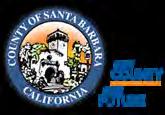PUBLIC SAFETY REALIGNMENT PLAN ADDENDUM


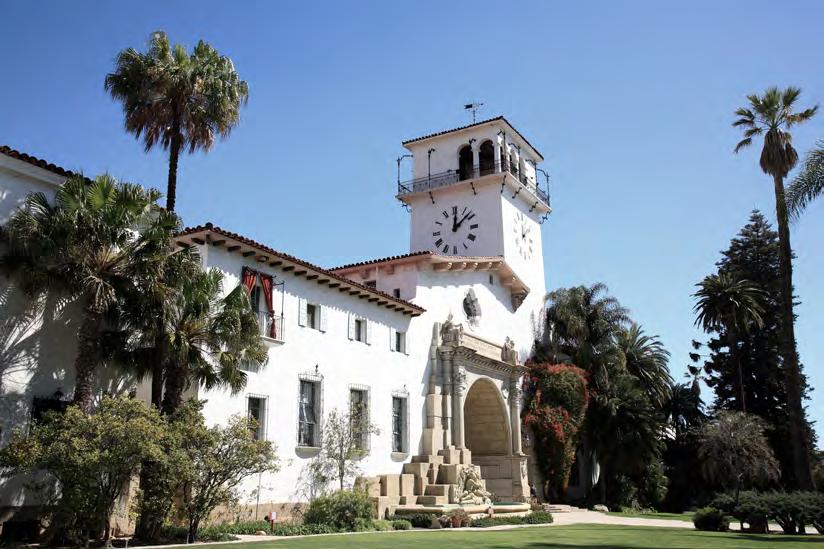








The Public Safety Realignment Act (Assembly Bill 109) was passed on October 1, 2011, with the objective to address overcrowding in California’s prisons and help alleviate the State’s financial crisis. Additionally, this Act expanded the role of the Santa Barbara County Community Corrections Partnership (CCP), which was established in the California Community Corrections Performance Incentives Act of 2009 (Senate Bill 678), and created a seven (7) member Executive Committee. The Act transferred the responsibility for specific inmates and parolees from the California Department of Corrections and Rehabilitation (CDCR) to counties. Subsequent to the passage of the Act in 2011, an annual plan for implementation of Realignment in Santa Barbara County has been brought before the Board of Supervisors (BOS) for approval and adoption.
The CCP Workgroup is tasked with the development of the Plan, and the yearly process includes presentations by departments regarding funded programs and services, budget discussions, and review of program data, including overall objectives and previous year’s performance. In general, the Realignment Plan does not change drastically from year to year; most objectives related to the goals set forth by the CCP are reevaluated after they have only been in place for a few months, which does not allow time for data to be developed and outcomes examined over time. In August of 2022, the CCP adopted a two‐year cycle for preparation of a full Realignment Plan, which requires that a narrative Addendum be provided every other year, to accompany the completed Realignment Spending Plan. This allows for additional time to accomplish and evaluate objectives. This year’s Addendum includes: narrative addendums for innovations or new programs, updated statistics, demographics, update to goals and objectives as applicable; and substantive program and/or budget changes.
To ensure the Realignment Plan goals and objectives remain a priority of the CCP, during this past year regular CCP and Workgroup meetings were held and attended by the membership, collaborative agencies, community members, and other stakeholders. Throughout 2022, and until March 2023, all CCP and Workgroup meetings were held on a virtual platform, pursuant to the provisions of Assembly Bill 361, which amended portions of the Brown Act to allow voting bodies to continue meeting virtually if specified conditions were met during the COVID‐19 pandemic. Overall participation by the public increased during this time as the virtual option reduced barriers presented when meetings are held in person. In March of 2023, meetings returned to a hybrid model of in person and virtual, which allows the public to continue to have remote access.
This Addendum summarizes the changes that have been made to address the needs of our community’s justice‐involved individuals, with a primary goal of reducing recidivism. The Addendum presents the CCP’s approach to public safety, using a client‐centered focus with emphasis on improving diversion, reentry coordination, community supervision, effective pretrial supervision, treatment interventions and victim support. The CCP supports the concepts of justice reinvestment and values the collaborative efforts between Departments and community‐based organizations (CBO). The CCP continued to review new program proposals, recidivism data, programmatic updates, new legislation, grant opportunities, pilot programs, and current trends in the justice system. For this year’s Addendum, the CCP relied on data collection and analysis to ensure decisions were informed and guided by evidence.
Each year, the CCP develops a plan for the Public Safety Realignment Act (Assembly Bill 109) and the Executive Committee of the Community Corrections Partnership (ECCCP) votes to approve the annual spending plan submission to the BOS. As required by statute, the annual plan and recommended programs are to be consistent with local needs and resources as applied to the Realigned population.
EXECUTIVE COMMITTEE OF THE COMMUNITY CORRECTIONS PARTNERSHIP
▪ Bill Brown, Sheriff/Coroner Santa Barbara Sheriff’s Office
▪ Tanja Heitman, Chief Probation Officer (Chair) Probation Department
▪ Tracy Macuga, Public Defender Public Defender’s Office
▪ Toni Navarro, Director Department of Behavioral Wellness
▪ Darrel Parker, Court Executive Officer Superior Court
▪ John Savrnoch, District Attorney Office of the District Attorney
▪ Marc Schneider, Santa Maria Police Chief Santa Maria Police Department
COMMUNITY CORRECTIONS PARTNERSHIP AT LARGE MEMBERS
▪ Sylvia Barnard, Executive Director Good Samaritan Shelter
▪ Kevin Carrol, Homeless Guest Services Director Santa Barbara Rescue Mission
▪ Daniel Nielson, Director Department of Social Services
▪ Susan Salcido, Ed.D., Superintendent County Education Office
▪ Luis Servin, Executive Director Workforce Development Board
▪ Das Williams, 1st District Supervisor County Board of Supervisors
COMMUNITY CORRECTIONS PARTNERSHIP (CCP) WORKGROUP1
▪ Holly Benton (Chair), Deputy Chief Probation Officer
Probation Department
▪ Michael Cash, Guadalupe Police Chief Guadalupe Police Department
▪ Paul Clementi, Budget Director County of Santa Barbara
▪ Darcel Elliot, 1st District Representatives County Board of Supervisors
▪ La Mer Kyle‐Griffiths, Assistant Public Defender Office of the Public Defender
▪ Toni Navarro, Director Department of Behavioral Wellness
▪ Mag Nicola, Chief Deputy District Attorney Office of District Attorney
▪ Darrel Parker, Court Executive Officer Superior Court
▪ Luis Servin, Executive Director Workforce Development Board
▪ Vincent Wasilewski, Chief Custody Deputy Santa Barbara Sheriff’s Office
1 Listed membership reflects individuals of the CCP Workgroup when the Addendum was developed


The implementation of Realignment created additional populations supervised locally by the Probation Department. These include individuals on:
Post Release Community Supervision (PRCS). These are individuals released from prison to local supervision after serving a felony commitment for a non‐violent, non‐serious and non‐high‐risk sex offense.
Mandatory Supervision Also referred to locally as Post Sentence Supervision (PSS). These are individuals sentenced pursuant to 1170(h)(5)(B)PC who qualify to serve their prison sentences locally in the County jail after being convicted of a non‐serious, non‐violent offense. Additionally, these individuals are not registered sex offenders and do not have a prior “strike” (serious and/or violent felony). The law allows for two (2) types of sentences; a straight commitment to County jail pursuant to 1170(h)(5)(A) PC or a split sentence 1170(h)(5)(B)PC which includes a period of time in jail followed by a period on mandatory supervision by Probation.
In comparison to the total number of individuals supervised by Probation, Realigned clients represent only 15% of the total supervised population in the County (Figure 2). However, Realigned clients are more likely to assess as high‐risk to reoffend or reoffend violently as compared to those on standard probation supervision (80% for PRCS clients and 71% for PSS as compared to 36% for those on standard probation supervision) (Figure 4).
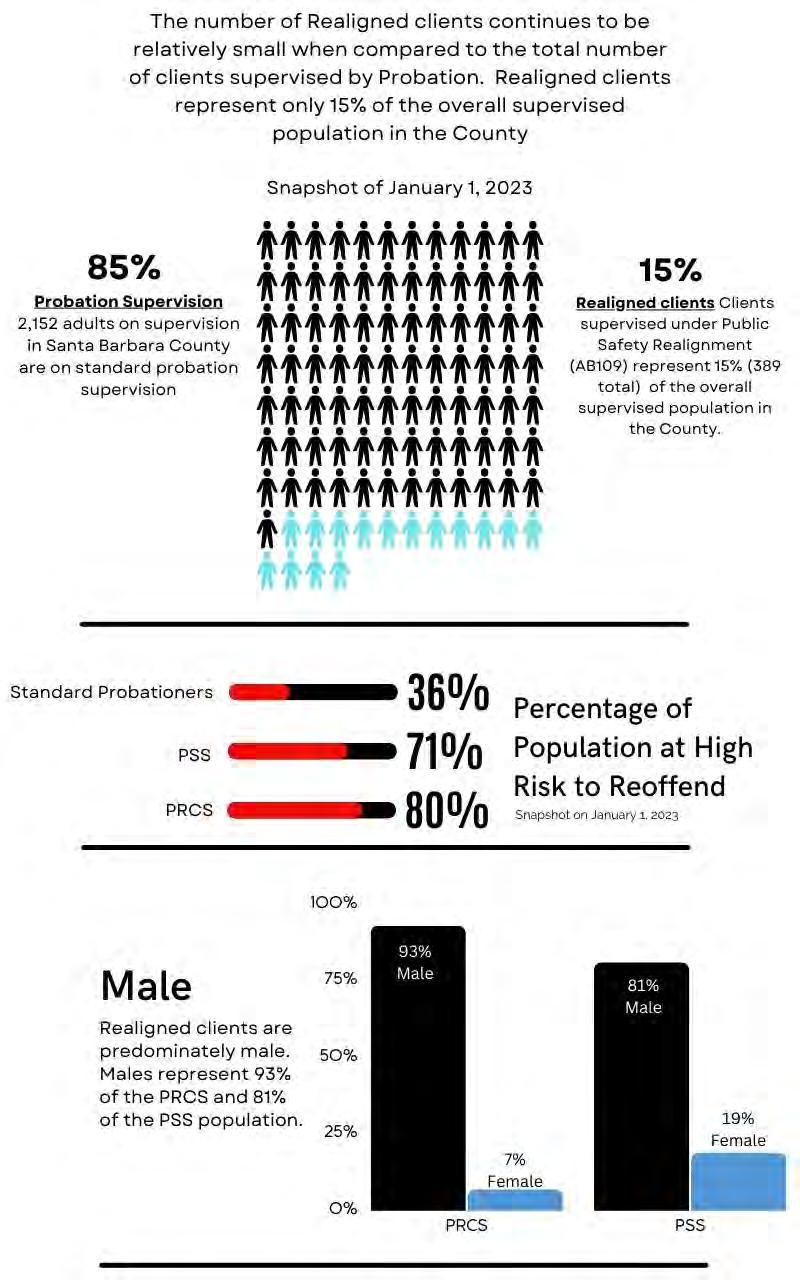
Recidivism is a key outcome measure for practitioners to evaluate the extent to which programs and services are changing behavior. As required by AB1050, the statewide definition of recidivism is a new felony or misdemeanor conviction three (3) years from the start of supervision or release from custody. This measure allows practitioners to examine the rates in which clients are reoffending in comparable time frames and allows greater comparisons to be made across clients, interventions, and time frames. Displayed below are data for eight (8) years of PRCS clients who started supervision in 2011 through 2018. For example, of the clients who started supervision in 2018, 42.6% recidivated within three (3) years‐by 2021. The clients’ highest recidivating event in that three years (either misdemeanor or felony) is also provided, the same information is also provided for PSS clients.
In 2017, the CCP identified a gap in service for forensic beds for inmates with severe mental health disorders and involvement with the criminal justice system who could not be properly treated at lower levels of care. In response, a one‐time allocation of $2.5 million was set aside to begin the process of designing and constructing a 15‐bed MHRC. In FY 2019‐2020, an additional $551,832 as a one‐time allocation was approved, for a total of $3,051,832 for the design and construction of a dedicated facility on the Calle Real Campus. Following a detailed evaluation by General Services and professional cost estimating services, the final cost as determined by the approved schematic design totaled $5.2 million. Due to the $2.1 million budget shortfall, as well as other local changes, alternatives to the MHRC were actively pursued.
In addition to the one‐time allocations, $1,103,665 has been included in the ongoing budget from FY 2018‐2019 through FY 2022‐2023 to cover ongoing operational costs for the MHRC. These funds have never been used for their intended purpose, because the MHRC has not been built. In April of 2021, the CCP approved the use $365,000 from the ongoing operational MHRC budget to fund two (2) reserved mental health rehabilitation beds at the Lompoc Crestwood Champions MHRC as a pilot project to divert clients that are Misdemeanants Incompetent to Stand Trial (MIST), and doubled this funding the following FY, for a total of four (4) beds.
The passage of SB 317 requires diversion and outpatient treatment of MISTs, and therefore impacted the use of the pilot beds. While the CCP remains committed to a more permanent solution, many partner agencies agreed a more immediate plan was needed. The Department of Behavioral Wellness (BeWell) submitted a recommendation that ongoing operational cost funding be re‐allocated to support a community mental health outreach program, dubbed “Familiar Faces.” This multi‐disciplinary effort will be led by Probation and involve staff from the Public Defender’s Office and BeWell. This team will provide community intervention to high utilizers who cycle in and out of custody, and provide immediate connections to services through a case management model.
Santa Barbara County has utilized three Co‐Response Teams countywide to respond to crisis calls in the community. Each Co‐Response Team consists of one Santa Barbara Sheriff Office (SBSO) Deputy and one BeWell Clinician who work as a collaborative unit. The teams have proven to be an effective intervention to address the behavioral health needs of individuals in the community experiencing a behavioral health crisis, who may otherwise end up being arrested or brought further
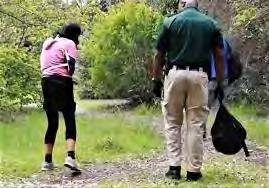
into the criminal justice system. Co‐Response teams are dispatched to active behavioral health calls in the community and utilize de‐escalation and other crisis intervention techniques to improve outcomes. The teams also participate in proactive outreach to individuals with known behavioral health concerns or who have recently been released from inpatient psychiatric care.
The teams have been effective in diverting individuals with behavioral health needs from the criminal justice system. In 2020, the Co‐Response teams demonstrated success by responding to nearly 50% of all documented SBSO mental health calls. Over time there has been an increase in volume and acuity of calls, as well as improved data collection and analysis. In FY 2021‐2022, the Co‐Response teams responded to nearly 300 active crisis calls. Of those calls, less than 4% lead to an arrest with 58% being de‐escalated in the field, and 29% placed on a psychiatric hold. The three teams are assigned regionally, with only one team in North County operating four days a week. This left three days of the week without Co‐Response coverage in the North and no team available to service the Lompoc community. Therefore, the CCP approved the addition of an additional team based in Lompoc to improve overall Co‐Response coverage countywide.
In FY 2022‐2023, the CCP approved an original allocation of $209,430 for the additional Co‐Response team. However, after further analysis it was determined an additional $174,130 was required to fully cover the additional costs to build out the team. An additional amount of $116,039 in one‐time funding to cover equipment and a vehicle was approved. For FY 2023‐2024, the CCP approved an on‐going amount of $383,560.
Santa Barbara County has a variety of Collaborative Courts within the Superior Court system to address cases in a specialized environment with a dedicated team. Investing in Collaborative Courts is specifically authorized under §1230(d) PC as a justice reinvestment strategy, which states that evidence‐based rehabilitation programs including, but not limited to, drug and alcohol treatment, mental health treatment, anger management, and cognitive behavior programs help maximize the effectiveness of criminal justice resources. Because the individuals assigned to these courts are often charged with Realignment‐eligible offenses, these courts can provide positive, therapeutic alternatives to jail that help end the cycle of recidivism.
It is anticipated the Collaborative Courts will see a continued increase in non‐probation supervised matters and enrollment that will require legal representation. In addition, an upward trend has been observed in the number of individuals participating in non‐probation supervised Military Diversion and Mental Health Diversion under Penal Code sections 1001.80 and 1001.36. The Collaborative Courts attorney will represent clients in court settings where alternatives to incarceration, such as drug rehabilitation, mental health diversion, and intensive case management, are provided, which can help to increase the use of diversion options. This attorney will work with individuals in the criminal justice system experiencing substance abuse challenges, mental illness, homelessness, and other social welfare concerns, using evidence‐based advocacy with a focus on recovery and connection to community‐based services. In addition, they will coordinate with other justice partners, community‐based organizations and social workers to optimize treatment and success.

For FY 2023‐2024, the CCP approved funding for a Deputy Public Defender for specialty and mental health court, as well as the conversion of three extra help positions to full time, including a legal office professional and two transporter positions, to further expand Holistic Defense options. The Public Defender’s Office has two Residential Treatment Program (RTP) transporters to provide transportation for clients and connect them to programs. The overall objective is to improve individual outcomes, minimize incarceration, and reduce recidivism.
For FY 2023‐2024, the CCP approved the funding of $283,500 for one full‐time Deputy Public Defender and $130,100 was approved to convert the two existing extra help RTP transporter positions and a legal office professional to full time positions for a total of $413,600 of ongoing cost.
In July of 2019, the Judicial Council of California awarded the Santa Barbara County Superior Court a grant to expand the Santa Barbara County Pretrial Program for the period of August 1, 2019, through December 31, 2021. In an effort to increase the safe and efficient release of arrested individuals with mental health challenges on pretrial supervision, two Mental Health Navigator (MHN) positions were funded by the grant. Due to the importance of the role the navigators played in the success of individuals on supervised pretrial release with mental health challenges during the grant period, the two navigator positions were funded by CCP for FY 2021‐2022 following the conclusion of the grant. During this grant period, it was further discovered that individuals with additional vulnerabilities other than mental health challenges could benefit from this service. Therefore, the CCP agreed to expand the scope of the navigator positions to extend the assistance beyond those with mental health challenges, to allow them to assist with all clients under pretrial supervision with identified vulnerabilities or other acute needs. To recognize the expansion of the scope, the positions were renamed Pretrial Services Navigators (PSN). The PSN positions initiate contact with individuals early on in the criminal justice process, attend court hearings, provide transportation to appointments or to obtain medication, link individuals to a variety of resources, and provide service coordination. The PSNs serve as a key influence in the success of the individual while on pretrial supervision with the ultimate goal of ensuring all individuals attend all their scheduled court hearings, pending criminal proceedings resolution.
In October of 2019, there were 129 individuals under pretrial supervision; in October of 2022, there were 524, a 306% increase. As of January 2023, there were nearly 600 individuals on pretrial supervision, and pretrial assessors were completing over 400 reports a month. In 2021, 38% of clients were supervised at the highest level of monitoring and this increased to 52% of clients in 2022. In FY 2022‐23, in response to the urgent need for additional pretrial navigators as pretrial services continued to grow at this rapid pace, Probation reallocated resources internally to the department in order to fund two navigator positions, and for FY 2023‐24, the CCP approved $192,965 to fund these two positions, so that all four pretrial navigators will now be funded through realignment.
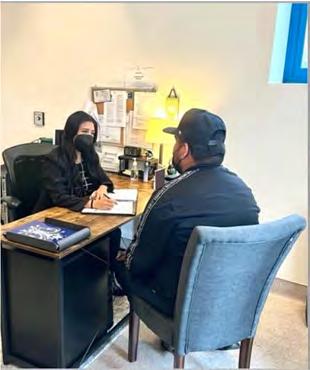
In addition, the growing pretrial population has meant an increase in the use of electronic monitoring of these clients, and that necessitated increases to the contract amounts for both GPS and SCRAM, an alcohol monitoring device, in the total amount of $104,500.

Probation Department partners with Community Services –Housing and Community Development Division to administer Supportive Transitional Housing. For FY 2023‐2024, CCP approved the ongoing allocation of $400,000 for Transitional Housing beds and services and an additional $120,000 to fund a Housing Program Specialist for program administration and to support the permanent housing project under development with Sanctuary Centers. The Housing Program Specialist will help with managing contract invoicing, and monitor program compliance and outcome measures while working in partnership with the Probation Department.
The Santa Barbara County District Attorney’s Office, in partnership with the Second District Supervisor’s Office, implemented a Neighborhood Restorative Justice Program (NRJP) pilot beginning in 2021 (previously referred to as Neighborhood Court). The pilot program served 37 first‐time offenders in the City of Goleta for the period of July 1, 2022 through December 31, 2022. NRJP pilot was modeled after the transformational Neighborhood Court program in Yolo County, CA. Yolo County has been at the forefront of the restorative justice movement in California and has become a model for other counties. NRJP is a restorative justice‐based pre‐filing diversion program for certain misdemeanor offenses and infractions. Through this program, a person who commits a qualifying offense appears before a panel of trained community volunteers to discuss the offense that took place, the impact of the offense on the community, and actions that the individual can take to make amends with the community and prevent future offenses from taking place. After meeting with NRJP volunteers, the participant would complete the agreed‐upon accountability actions, such as community service, letters of apology, educational opportunities, counseling, etc. Upon the participant’s successful completion of accountability actions, the District Attorney’s Office does not file the charge in court.
Benefits of an NRJP include diverting low‐level offenses through a restorative justice process that promotes accountability, increased community involvement in advancing public safety, and a reduction in time and money spent on adjudicating low‐level offenses in court.
The District Attorney’s NRJP is based upon a victim‐centered approach. A victim‐centered approach can help better meet the needs of victims and strengthen ties between the offender and others, including the community, thereby promoting resistance from crime for participating offenders and increasing satisfaction with the justice system for participating victims.
One‐time CCP funding has paid for one (1) staff member to oversee the NRJP pilot and costs associated with training and technical assistance. This staff member works in conjunction with other District Attorney staff, Neighborhood Court volunteers, law enforcement partners, and community stakeholders
in carrying out the program. For FY 2022‐2023, $150,000 was allocated to fund the NRJP as one‐time funds from the Programmatic Restricted Fund Balance.
In order to expand services to other parts of the county, the CCP awarded additional funding to the District Attorney’s Office in early 2023 to expand the NRJP countywide, for a total allocation of $291,700 in ongoing funding and $70,000 in one‐time funding for FY 2023‐2024. The success of the countywide NRJP will be monitored by an independent evaluator utilizing multiple key metrics for success.
The CCP has continued to seek innovative and promising programs, services, and solutions to address the needs of the County’s adult supervision population. The targeted population for new programs and services are those designated as Realigned clients, those in custody, and the pretrial population as well as those in need of reentry services throughout the county. The one‐time funding opportunities provide community partners with a unique opportunity to propose pilot programs or innovative programs and measure their impact. The approved programs awarded one‐time funding by the CCP for FY 2023‐2024 are as follows; District Attorney (DA) felony diversion needs assessment, Freedom to Choose and GRID Alternatives.
The Santa Barbara County District Attorney’s Office intends to implement a felony diversion program for individuals charged with lower‐level felonies to address specific individual criminogenic needs. The goal of the diversion program is to respond more effectively to the needs of program eligible adults by using research‐based programs that address specific individual criminogenic needs, reduce future contact with the criminal justice system, increase connections to appropriate community‐based systems of care, and hold individuals accountable for their criminal conduct through a human‐centered, restorative approach that also ensures victim restitution is made. The program includes interviewing stakeholders, facilitating community meetings to solicit feedback on what type of pre‐plea diversion program the local community would support, reviewing eligibility criteria to determine the types of felonies that can be diverted, identifying services and providers appropriate for felony offenses, and a review of case processing that focuses on the individual rather than the offense.
The budget for the six‐month project is $56,848 and includes training and technical assistance to the Santa Barbara County DA’s Office to help with planning, policy analysis and data review, stakeholder engagement, community engagement, resource mapping, and finalizing eligibility criteria recommendations.
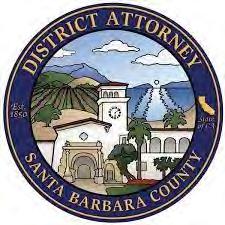
The SBSO partnered with Freedom to Choose (FTC) project, a non‐profit program, to pilot the Pathways to Freedom Self‐Directed Learning Program in Santa Barbara County Jails to replicate the self‐study rehabilitation program currently conducted in multiple California state prisons. The program is designed to transform the lives of individuals impacted by incarceration through compassionate experiential education. FTC programming is evidence‐informed and the pilot project will target up to 100 incarcerated individuals per year.

FTC uses a culturally responsive, bilingual (Spanish) curriculum incorporating evidence‐based cognitive‐behavioral approaches, emotional intelligence skills, resilience cultivation, and trauma/violence reduction skills along with other proven psychological modalities. FTC teaches practical empathetic communication, emotional competency, and self‐responsibility skills. In response to COVID‐19, FTC developed a modified self‐study written correspondence program provided to participants that will be administered at the Santa Barbara County Jail.
The Pathway to Freedom Self‐Directed Learning Program curriculum offers a module‐based insight‐oriented program designed to support “Change from the Inside” through the practicing of skills necessary for healing trauma, building emotional intelligence, and cultivating empathy and resiliency regardless of the individual’s setting. The module‐based insight‐oriented, daily application of learning is designed to build skills such as emotional intelligence, problem‐solving, self‐regulation, communication, cultivating inner peace, and self‐reflection.
The objective of the program is to support the participants in gaining the necessary insight and awareness leading to sustainable, prosocial change. Participants will be supported in continuing the program upon release from the SB Jail through participation in FTC’s monthly online events where they will have an opportunity to join community members in practicing the skills.
As aligned with the objectives of CCP, this program is designed to provide a positive behavioral change in justice‐involved individuals and prepare them for successful reentry into the community. The CCP approved funding for the program in the amount of $30,000 for the first year of the program.
The SBSO partnered with GRID Alternatives, a non‐profit solar installer and training provider, to provide onsite job training in photovoltaic installation to incarcerated individuals at the Santa Barbara County North Branch Jail located in Santa Maria. GRID Alternatives solar installation and training provides hands on training through task repetition in order for individuals to gain the required skills for entry‐level solar installation. The skills include construction and electrical basics, interpreting and comprehension of National Electric Code and North America Board of Certified Energy Practitioners concepts, and demonstration of industry related Occupational Safety and Health Administration (OSHA) safety training.

Grid Alternatives will implement a sixty (60) hour introductory course over five (5) weeks onsite at the Santa Barbara County North Branch Jail using a mock roof and other materials. Participants will be required to complete assessments covering job site safety, fall protection, and electrical safety. Further, prior to the conclusion of the program, participants will be evaluated following an observation of installation techniques and required to display competencies aligned with the GRID Alternatives Installation Basics Training Syllabus.
The objective is to offer four (4) of the five (5) week training sessions during the first year of the program with up to ten (10) participants for a total of forty (40). If participants pass the set objectives of the OSHA‐10 Training and Assessment Tests, they will receive an OSHA‐10 “hard card” conferring lifetime safety certification which can increase the likelihood of being hired in the industry. Additionally, the program will assist individuals completing job resumes, job‐ready documentation, and DMV identification applications. Participants who complete the program will also receive an industry ready tool bag complete with all the tools necessary to begin employment in the community.
As aligned with the objectives of CCP, this program will provide participants the ability to gain the skills required for entry level positions in the solar industry, ultimately increasing the likelihood of successful reentry to the community with viable employments opportunities. The CCP approved funding for the program in the amount of $139,520 for the first year of the program, which includes start‐up costs.

Public Safety Realignment places significant responsibility on the local jurisdiction and brings with it numerous challenges; however, by offering considerable flexibility, it also presents opportunities. The local CCP is committed to mitigating challenges and seizing these opportunities to improve the local criminal justice system. To guide the local efforts and provide focus to the designated resources, the following goals, objectives, and outcomes have been developed. The CCP continues to refine its objectives to ensure services, programs and strategies are aligned with the overarching goals, and that these goals continue to guide the realignment work of partner agencies and community‐based organizations working with the realigned and pretrial populations.

Reducing recidivism is the primary focus of Santa Barbara County’s Realignment efforts. Strategies for affecting the drivers of criminal behavior require the use of evidence‐based programs delivered to model fidelity. Not only has the CCP endorsed the utilization of programs proven to reduce recidivism, it has leveraged its work with “Results First” to guide resource allocation decisions.
Deliver evidence‐based programming that is data‐driven and matched to Realigned clients’ risks and needs.
As of December 31, 2022, 30% of Realigned clients successfully discharged from a CBT intervention such as R&R, Thinking for a Change, MRT, or Seeking Safety showed improvement in four (4) of the six (6) domains of the TCU Criminal Thinking Scales between pre and post‐test, not realizing the 50% goal for this objective.
50% of Realigned clients successfully discharged from a CBT intervention such as R&R, Thinking for a Change, MRT, or Seeking Safety will show improvement in four (4) of the six (6) domains of the TCU Criminal Thinking Scales between pre and post‐test.
Expand the use of best practices for evidence‐based sentencing and adjudication that utilizes Realigned clients’ specific risk, needs, and responsivity measures.
How and to what extent COVID‐19 influenced reoffending and crime rates has yet to be determined. With this acknowledged, Santa Barbara County Superior Court and Probation records indicate the percentage of Realigned clients with a new felony or misdemeanor conviction three (3) years from the start of supervision or release from custody as:
42.6% for PRCS clients. This is a decrease from 44% and exceeds the FY 2022‐2023 goal of 44%.
40% for PSS clients. This is a decrease from 51% and exceeds the FY 2022‐2023 goal of 45%.
Percentage of clients with a new felony or misdemeanor conviction 3 years from the start of supervision or release from custody will not exceed 42.6% for PRCS clients and 40% for PSS clients.
Support professional training to advance system‐wide knowledge of evidence‐based practices in the criminal justice field.
It is projected that as of June 30, 2023, ten (10) training opportunities related to evidence‐based practices and/or interventions will be provided to staff, meeting the goal of ten (10) for this objective.
Ensure no less than ten (10) training opportunities related to evidence‐based practices and/or interventions are provided to staff and service providers.
Enhance
The CCP is focused on reducing the reliance on incarceration through the utilization of alternative sentencing options for appropriate justice‐involved individuals. Research‐based assessment instruments are used to assure the safety of the community and reduce unnecessary detention for eligible individuals including those who are awaiting trial and those already sentenced.
Utilize evidence‐based assessment tools for pretrial and post‐sentence jail release decisions.
From July 1, 2021, to June 30, 2022, 20% of defendants failed to appear or absconded during their pretrial monitoring period, not meeting the 15% goal for this objective.
Reduce pretrial supervision completions as a result of failure to appear or absconding from 20% to 15%. Barriers of this population identified to date include transiency, substance abuse, and mental illness.
Strive to maximize jail capacity for highest‐risk clients and identify those who can be safely released.
As of December 31, 2022, 70% of inmates held in the jail over two (2) weeks had an Initial Screening Tool (IST)2 or COMPAS completed, not meeting the FY 2022‐2023 goal of 80%.
Additionally, as of December 31, 2022, 9% of the total housed jail population were assessed as low‐risk to reoffend meeting the 9% goal for this objective.
80% of inmates held in the jail over two (2) weeks will have an IST completed. Additionally, no more than 9% of the total housed jail population will be assessed as low‐risk to re‐offend.
Expand the diversion of individuals from the justice system.
From July 1, 2022, to December 31, 2022, 37 individuals enrolled in the Neighborhood Restorative Justice Program (NRJP), not meeting the goal of 50 for this objective.
Divert no less than 100 individuals from the justice system to the NRJP.
the use of alternative detentions (pre‐ and post‐sentence) for appropriate justice‐involved individuals3.
The CCP is committed to coordinating and providing services to prepare justice‐involved individuals for the successful return to their community after a period of incarceration. Strategies include providing needed rehabilitative services, removing barriers to housing as well as capturing community input on program development and other justice system reform efforts.
Provide services and treatment in partnership with existing community providers.
Facilitate access to sober living and transitional housing, as well as long‐term supportive housing.
Promote a shared safety approach in conjunction with community partnerships and engagement.
Number of clients evaluated for referral through Community Defender Division (CDD) to services including shelter, housing, drug treatment, mental health treatment, and vocational services.
The grant supporting the Prison to Employment (P2E) initiative expired March 2022. Employment services were subsequently provided by Goodwill Industries. Between July 1, 2022, and December 31, 2022, 62% or 8 of 13 individuals enrolled in services and secured employment, exceeding the FY 2022‐2023 goal of 49%.
From July 1, 2022, through December 31, 2022, 56% or 10 of 18 clients exiting supportive housing secured stable housing, exceeding the FY 2022‐2023 goal of 25%.
As of December 31, 2022, development of a local plan for ongoing community engagement for public safety‐related discussions and decision making remained outstanding, not meeting the goal for this objective.
Ensure no less than 50% of individuals enrolled in employment services secure employment.
No less than 56% of clients exiting supportive housing will secure stable housing.4
Develop a local plan for coordinated and ongoing community engagement for public‐safety related discussion and decision making.
79% of clients experiencing homelessness at first contact were connected to housing services by the Community Defender Division (198 of 251), exceeding the FY 2022‐2023 goal of 56.7%.
Connect no less than 68% of advocate referrals of clients experiencing homelessness at first contact to housing services.
Coordinate efforts to eliminate duplication, enhance efficiencies, and promote best practices.
Working collaboratively, the CCP is able to address emerging issues to support the Realigned population and promote community safety. These efforts have included data integration across systems, the evaluation of Public Safety Realignment practices and programs, and fidelity reviews of delivered evidence‐based programs.
Ensure fidelity to the research‐based models for funded programs.
It is projected that by June 30, 2023, no less than 90% of funded evidence‐based programs will have completed curriculum specific fidelity reviews meeting the outcome for this objective.
To assess quality and monitor program fidelity—how closely a program adheres to its research‐based design— ensure no less than 90% of funded evidence‐based programs have completed curriculum specific fidelity reviews.
Evaluate adherence to evidence‐based strategies.
As of December 31, 2022, recommendations outlined in the September 27, 2021, University of Cincinnati Corrections Institute (UCCI) report were prioritized and an action plan to systematically address no less than four (4) of the identified areas to increase adherence to evidence‐based practices in the adult Probation division was developed.
Implement action plan to systematically address no less than four (4) of the identified areas to increase adherence to evidence‐based practices in the adult Probation division.
Collaborate with justice partners for information sharing and coordination of efforts around best practices.
Recruitment of a Multi‐Agency Assessment, Case Planning and Reentry Coordinator was initiated in FY 2022‐2023. However, as of February 1, 2023, no one had been selected for the position.
Hire a Multi‐Agency Assessment, Case Planning and Re‐Entry Coordinator to coordinate and ensure all diversionary options are maximized, individuals entering the jail receive multi‐agency assessments and case planning, and any individuals exiting the jail are provided a robust discharge plan and a warm handoff as appropriate.
Capture and integrate data necessary to measure outcomes.
Data collection to inform the need for a Mental Health Rehabilitation Center (MHRC) was not initiated in FY 2022‐2023 as a result of the passage of Senate Bill (SB) 317 and the opportunity to shift focus to early intervention and community outreach in lieu of a locked forensic treatment center.
Design and implement a multi‐agency model to support a community mental health outreach program in Santa Barbara County.
The CCP is committed to understanding the extent to which racial and ethnic disparities exist within the criminal justice system. The partnership maintains its commitment to ensuring all justice‐involved individuals are treated with dignity, respect, and humanity. In FY 2023‐2024, the partnership will focus on expanding its understanding and impact of racial and ethnic disparities in the justice system and addressing and implementing processes to assist in reducing disproportionality.
Partner with local justice partners to educate staff and stakeholders and strategize approaches to address any racial and ethnic disparities in the local justice system.
On October 26, 2022, the California Policy Lab (CPL) presented changes in jail bookings and release, jail length of stay, and jail rebooking rates in Santa Barbara County over the COVID‐19 period, meeting the goal for this objective.
Research approaches and tools for action that ‐ in partnership with communities ‐ guides pro‐equity policy and decision‐making, planning, operations, and services, to advance equity and social justice of the justice partners within Santa Barbara County. Use county‐specific findings on racial and ethnic disparities to inform decision‐making.
Solicit input from justice involved clients and/or victims on the challenges faced and receive feedback on treatment within the criminal justice system to ensure all are treated with dignity, respect and humanity.
As of December 31, 2022, a community REEI survey had not been launched and an action plan to address key findings was not developed.
As of March 1, 2023, all justice‐partner agencies5 had implemented no less than one (1) policy or practice to reduce racial and ethnic disparities and advance a culture of equity.
Findings from a survey of justice‐involved individuals were explored and a plan of action developed to improve discharge planning and service delivery for clients returning to the community. In FY 2022‐2023, this included partnering with 2‐1‐1 to offer free transportation as well as strengthening the discharge planning process to include enhanced outreach to disengaged clients.
Continue implementation of plan to address service barriers including transportation, housing, and qualification for services. Collect additional feedback from justice‐involved clients to gain further insight into these and other areas that may require attention for improvement.
While the health crisis and challenges of the COVID‐19 pandemic have waned, local stakeholders and departments within the community corrections landscape have utilized lessons learned from resulting operational changes during the pandemic and continue to look for enhancements and efficiencies in services offered. Reducing incarceration, increasing diversion opportunities, improving reentry coordination, and enhancing services for clients and victims have been on the forefront of the work completed by the CCP.
The number of clients released on pretrial supervision continued to grow, requiring more resources and staff, which resulted in the addition of two (2) Pretrial Service Navigators. The Santa Barbara County North Branch Jail continued to look at advancements to programming for inmates and look forward to offering a Solar Installation training in a partnership with GRID solar, as well as the Freedom to Choose Program. The District Attorney’s Neighborhood Justice Program launched in Goleta, to assist with the diversion of individuals with minor offenses. While very little data is currently available on the program, the District Attorney’s Office is optimistic about expanding these efforts into the northern region of Santa Barbara County, and providing a robust data evaluation of their countywide program. The Public Defender’s Office has escalated several positions from part time to full time and now have the funding for a dedicated attorney in the collaborative courts, which has seen an increase in the use of diversion.
Justice system partners throughout the County of Santa Barbara remain committed to innovation and evidence‐based practices to improve public safety. Discussions and decisions remain guided by data‐driven management and evidence‐based strategies and these efforts will continue into the coming year.

The proposed FY 2023‐2024 budget of more than $20 million demonstrates alignment with the CCP efforts which focus on jail population management, pretrial services, alternative sentencing, case management, supervision, treatment services and support for Realigned clients.
The budget includes an allocation of $226,039 of restricted fund balance to one‐time Realignment program related needs, as follows: District Attorney’s NRJP ‐ Media Costs $25,000 & Data Evaluator $45,000, Data needs for the Criminal Justice Data Committee (CJDC) $40,000, Co‐Response Team Efforts $116,039.
The charts included in the following pages detail:
1. FY 2023‐2024 Public Safety Realignment Act Budget
2. Public Safety Realignment Act (AB109) Restricted Fund Balance Trend Summary
3. AB109 Restricted Fund Balance and FY 2023‐2024 One‐Time Allocation

4. A Five‐Year Use/Source of Funds Trend Summary
5. A Five‐Year Use/Source of Funds Trend (Detail)
FY 2023-2024
By Project Component
FY 2023-2024 Estimate By Project Component
FY 2023-2024 Estimate By Project Component
Public Safety Realignment Act (AB109) Restricted Fund Balance
Program Restricted Fund Balance
Planning Restricted Fund Balance
Implementation Restricted Fund Balance
AB109 Restricted Fund Balance and FY 2023-2024 One-Time Allocation
*Although funds were encumbered in FY22-23 they are not anticipated to be fully expended in FY22-23
FY 2023-2024
COUNTY OF SANTA BARBARA
